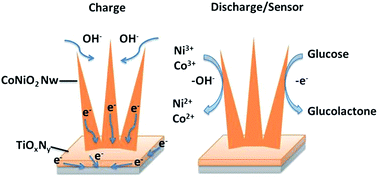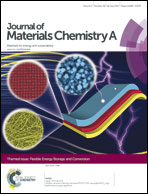CoNiO2/TiN–TiOxNy composites for ultrahigh electrochemical energy storage and simultaneous glucose sensing†
Abstract
We report a rational growth of functional CoNiO2/TiN–TiOxNy composites on flexible Ni foam for ultrahigh energy storage with fast charging capability and simultaneous non-enzymatic glucose detection. The TiN–TiOxNy intermediate layer provides both fast electron transport and a uniform growth substrate for polycrystalline mesoporous CoNiO2 NWs, at the same time preventing corrosion of the Ni substrate. Ultrahigh areal pseudocapacitance of 3181 and 2763 F g−1 (or 3.36 and 2.83 F cm−2) is obtained from the CoNiO2/TiN–TiOxNy composite at current densities of 2 and 10 mA cm−2, respectively; these values are substantially better than those obtained from the plain CoNiO2 NWs at the same current densities. Furthermore, the CoNiO2/TiN–TiOxNy composite exhibits high flexibility and cycling stability, and can be charged up to 1.64 F cm−2 within 9 seconds at a high current density of 100 mA cm−2. Moreover, after being fully charged, the CoNiO2/TiN–TiOxNy composite-based pseudocapacitors can maintain an extended discharge time of hundreds to thousands of seconds, and are demonstrated as power-free sensors for real-time electrochemical detection of glucose, with a detection limit of ∼1 μM.

- This article is part of the themed collection: Flexible energy storage and conversion

 Please wait while we load your content...
Please wait while we load your content...